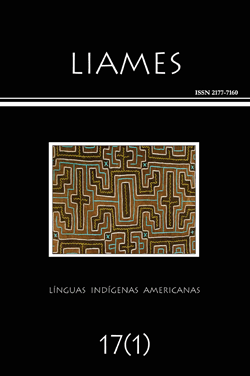Abstract
Panoan languages are mainly suffixing. However, also have a closed group of approximately 30 prefixes. Various analyzes have been proposed about the origin of the prefixes, but recognizes the need for more data about this phenomenon in different panoan languages. In this context, this article presents a synchronic description of body part prefixes in Iskonawa (Ucayali, Peru), obsolescence and endangered panoan language. Thus, an inventory of the prefixes is shown in relation to the roots which, in the language, denominate any part of the body. Also, the properties of the prefixes in the phonological, morphophonological and morphosyntactic levels are described. In addition, the patterns of correspondence that are evidenced between these prefixes and their corresponding roots are reviewed. Using data from Iskonawa, the synchronic relation that has been used to explain the origin of the prefixes in other panoan languages is questioned, as well as the plausibility of the diachronic hypothesis that other scholars have proposed for this phenomenon in the panoan family as a whole.References
Amarante, Lincoln; Cândido Gláucia (2008). A formação de palavras a partir de morfemas monossilábicos nominais e bases verbais em línguas indígenas da família pano: Prefixação ou incorporação nominal? Revista de Estudos Linguísticos VEREDAS 1: 129-145.
Barabec de Mori, Bernd; Jefferson, Pérez Casapía (2006). Los iskobakebo: La historia del contacto de los misioneros con un pueblo de habla pano en Ucayali. Disponible en
http://centroderecursos.cultura.pe/es/palabrasclave/iskobakebo
(Acceso: 19/01/2016).
Eakin, Lucille (1991). Lecciones para el aprendizaje del idioma yaminahua. Documento de Trabajo N° 22. Yarinacocha: Instituto Lingüístico de Verano.
Faust, Norma (1973). Lecciones para el aprendizaje del idioma shipibo-conibo. Documento de Trabajo N° 1. Yarinacocha: Instituto Lingüístico de Verano.
Ferreira, Rogério Vicente (2001). Língua Matis: Aspectos descritivos da morfossintaxe (Dissertação de mestrado). Campinas: Universidade Estadual de Campinas.
Disponible em:
http://www.repositorio.unicamp.br/bitstream/REPOSIP/268999/1/FERREIRA%2c%20ROG%3fRIO%20VICENTE.pdf
Ferreira, Rogério Vicente (2008). Morfemas ‘partes do corpo’ em matis e algumas línguas da família pano. Raído 2(4): 35-39.
Faust, Norma; Loos, Eugene (2002). Gramática del idioma yaminahua. Serie Lingüística Peruana 51. Lima: Instituto Lingüístico de Verano.
Fleck, David W. (2006). Body-part prefixes in matses: Derivation or noun incorporation? International Journal of American Linguistics 72(1): 59–96.
Fleck, David W. (2013). Panoan languages and linguistics. Anthropological Papers of the American Museum of Natural History 99. New York: American Museum of Natural
History. Disponible en:
http://biblio.wdfiles.com/local--files/fleck-2013-pano/fleck_2013_pano.pdf
Hall de Loos, Betty; Loos, Eugene (1971). Palabras y frases del idioma isconahua (Manuscrito). Información de campo N° 111-b. Instituto Lingüístico de Verano.
Hall de Loos, Betty; Loos, Eugene (1998). Diccionario capanahua–castellano (Serie Lingüística Peruana 45). Yarinacocha: Instituto Lingüístico de Verano.
Hall de Loos, Betty; Loos, Eugene (1973). La estructura semántica y fonológica de los prefijos verbales en capanahua. En Eugene Loos. Estudios panos 1, pp. 63-132 (Serie Lingüística Peruana 10). Yarinacocha: Instituto Lingüístico de Verano.
Hyde, Sylvia (1980). Diccionario amahuaca (Edición Preliminar) (Serie Lingüística Peruana 7). Yarinacocha: Instituto Lingüístico de Verano.
Kensinger, Kenneth (1961). Brief vocabulary (Manuscrito). Información de campo N° 111-a. Instituto Lingüístico de Verano.
Loriot, James; Erwin Lariault; Dwight Day (1993). Diccionario shipibo–castellano (Serie Lingüística Peruana 31). Yarinacocha: Instituto Lingüístico de Verano.
Loos, Eugene E. (1976). Estudios panos V: Verbos performativos (Serie Lingüística Peruana 14). Yarinacocha: Instituto Lingüístico de Verano.
Momsen, Richard P. Jr. (1964). The isconahua indians: A study of change and diversity in the Peruvian Amazon. Revista Geográfica 60: 59-82.
Montag, Susan (1979). Lecciones para el aprendizaje del idioma kashinawa (Serie Datos Lingüísticos 59). Lima: Instituto Lingüístico de Verano. Disponibel en:
https://www.sil.org/resources/archives/29942
Prost, Gilbert R. (1967). Chacobo. En Esther Matteson (ed.). Bolivian indian grammars 1, pp. 285-359. México D.F.: Instituto Lingüístico de Verano, la Universidad de Oklahoma. Disponible en: https://www.sil.org/resources/archives/8639
Rodríguez Alzza, Carolina (2015a). Prefijos de partes del cuerpo en la lengua iskonawa (Pano-Perú): Una descripción sincrónica. (Tesis para optar el grado de licenciada en lingüística). Lima: Pontificia Universidad Católica del Perú.
Rodríguez Alzza, Carolina (2015b). Relaciones gramaticales en la lengua iskonawa. Revista Lengua y Sociedad 15(1): 45-58.
Russel, Clifton (1960). Isconahua vocabulario lista (Manuscrito).
Scott, Marie (2004). Vocabulario sharanahua castellano. Lima: Instituto Lingüístico de Verano.
Shell, Olive (1957). Cashibo II: Grammemic analysis of transitive and intransitive verb patterns. International Journal of American Linguistics 23(3): 179–218.
Shell, Olive; Wise, Mary Ruth (1971). Grupos idiomáticos del Perú. Segunda Edición. Lima: Instituto Lingüístico de Verano y Universidad Nacional Mayor de San Marcos.
Steinen, Karl von (1904). Diccionario sipibo. Berlin: Deitrich Reimer.
Valenzuela, Pilar (2003). Transitivity in Shipibo-Konibo grammar (Tesis de doctorado). Oregon: University of Oregon.
Whiton, Louis C.; Greene, Bruce H.; Momsen, Richard P. Jr. (1964). The isconahua of the remo. Journal de la Société des Américanistes 53: 85-124.
Zariquiey, Roberto (2015). Bosquejo gramatical de la lengua iskonawa. Boston: Latinoamericana Editores, Centro de Estudios Literarios Antonio Cornejo Polar-CELACP y Revista de Crítica Literaria Latinoamericana.
Zariquiey, Roberto; Fleck, David W. (2012). Body-Part prefixation in Kashibo-Kakataibo: Synchronic or diachronic derivation? International Journal of American Linguistics 78(3): 385-409.
Zingg, Philipp (1998). Diccionario chakobo–castellano, castellano–chakobo con bosquejo de la gramatica chacobo y con apuntes culturales. La Paz: Ministerio de Desarrollo Sostenible y Planificación Viceministro de Asuntos Indígenas y Pueblos Originarios.
The LIAMES: Línguas Indígenas Americanas uses the Creative Commons license (CC), thus preserving the integrity of the articles in an open access environment.



